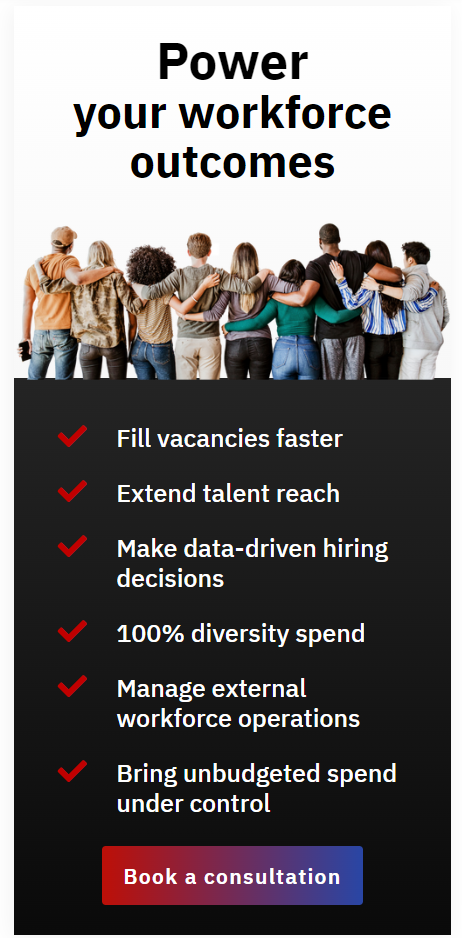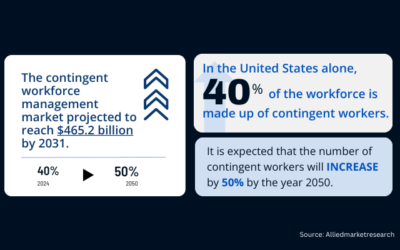
Nicole Wilson - 5 min read
The Shadow Labor Force
In the presently challenging macroeconomic environment, every organization, every business, every team needs to do more with less. Given that labor can run up to 70% of an organization’s costs, a necessary outcome of this need is a focus on optimizing and maximizing productivity from an organization’s talent pool.
One reason talent is top of mind stems from the belief that almost every enterprise’s success or failure can ultimately be brought back to its people. Looking across the business landscape, there are multiple examples of how one organization (e.g. Meta, aka Facebook) out hustled and over performed against rivals (e.g. Peerspace) to entrench themselves as leaders within their respective market.
Ignorance is NOT bliss
The challenge, however, is that during talent optimization discussions, the primary and often exclusive focus is on employees or FTEs. Little, if any, regard is paid to contingent or contract workers in an organization. Oftentimes this group isn’t even considered in talent conversations; it’s almost as if they’re “invisible.” This may be due to the nature of work given to contractors in the organization, which is often the laborious, tedious, and mundane work of “keeping the lights on” (KTLO).
Additionally, this group may be overlooked due to the decentralized or project-based budgeting and management of these resources. Or it may be because organizational leaders often have very limited line of sight visibility into contract labor pools, which may be managed at a much lower level in the company.
Commonly, teams in various parts of the organization hire and manage contract labor with preferred vendors through Statements of Work (SOWs) or some other similar commercial arrangement. Subsequently, executive management or the “home office” is unaware of the existence of this talent, their need, or value.
Research done across multiple studies points to nearly every organization employing contract or contingent labor, oftentimes in very substantial amounts. Therefore, it’s very likely every organization has a substantial pool of contractors working on its behalf but is often blissfully unaware of their presence. However, that ignorance is NOT bliss. An organization is not able to properly manage, optimize, and motivate a talent pool of which it is unaware.
In an environment where every dollar needs to drive value, not being aware of and successfully managing a substantial group of people does the whole organization an incredible disservice.
Harnessing the shadow labor force
In thinking about how to manage the contract labor pool, companies have to first understand the nature and extent of this group of talent. This can be done through a number of techniques, including audits, surveys, and assessments of the organization as a whole.
While these audits may be uncomfortable interactions and lead to difficult conversations, ultimately, getting a better understanding of the contract labor force will enable the organization to harness this talent for its betterment. The opportunity to better utilize contract labor comes from better alignment with overall corporate initiatives.
Commonly, teams will deploy contractors to solve a specific problem creating a point solution. The challenge with a myriad of point solutions is that no one solution works with any other solution, and this leaves the organization with lots of little “towers” that don’t talk to one another. Think about it from the perspective of our national air traffic control system – each tower communicates with each other as needed to route planes from one region to another. If these towers didn’t speak to one another – there would be massive chaos and casualties, on a daily basis.
This is often the case with clients today with their use of contractors. There is no unified approach to managing and aligning contractors to help ensure all the “wood” is behind the corporate objective represented by the “arrow.” Additionally, contractors are often employed by groups to take on repetitive and tedious work. Often the intent of hiring contractors is to “free up” more “value add” FTE employees to take on the more challenging and higher value-add work.
The problem with this approach is the eventual and logical decline in the output and value of the contractor’s labor. People have a finite limit for how long and successfully they can accomplish low value-add work. Unfortunately, even though the work may be mundane, it is often a critical part of the success of the overall organization, which then has the consequence of leading to a reduction in value for customers of the business.
A final aspect which may impact harnessing of contingent labor lies in their potential lack of cultural adhesion and alignment with the values of the organization. Contractors have a difficult feeling a “part” of any corporate culture or activities. Enabling that common sense of purpose is made more difficult without a solid understanding of who they are and what they do for the company. Incorporating contactors into the organizational “fold” is fraught by multiple challenges as it’s necessary to still maintain their arms-length contractor status.
Arm’s length relationship
Ensuring your organization optimizes the use of contract labor, while at the same time maintaining the legally necessary distance to protect your organization, can be a very difficult balancing act. Working through the motivations and career aspirations of contractors and contingent staff can be extremely difficult, but it is a necessary component of ensuring maximum value from this talent pool.
Think about it from the perspective of the contractor working in a client organization; if it doesn’t move their career aspirations forward it is simply a “placeholder” role until something better or different comes along.
The challenge for any organization is the low value-add when talent is merely operating with a “placeholder” mentality, even if that person is a contractor. A good customer experience and success in the marketplace can easily be negatively impacted by a call center contractor who is merely “whiling away their time” and waiting for a more impactful career opportunity. Therefore, it’s critical to not only understand what the motivations are for contractors, but how your organization can work with companies who have experience managing their expectations successfully, all while maintaining the distance required by law.
Furthermore, access to unique talent pools and skills can often be difficult for an organization to do without working with outside experts, like Workspend Inc. The difficulty arises when companies try to attract talent with unique capabilities, for which their organization is not known or where they are not in the consideration set for the talent. Access to this unique talent is made even more difficult by the need to maintain an arm’s length distance from these contractors.
Utilizing an expert like Workspend Inc. who can devise direct sourcing programs to enable your organization to tap into unique labor pools, while leveraging your brand and market position, is a critical element of success for most organizations. Whether it’s accessing differentiated talent or ensuring that talent is motivated to put in the effort to succeed for your organization, it’s critical that the company recognize how to make successful use of contractors while at arm’s length.
Managing what you can measure
One of management guru Peter Drucker’s most famous quotes is “You can’t manage, what you can’t measure”. While not everything every management guru espouses stands the test of time, this particular insight is critical for successfully managing contingent and contract labor. If you’re unable to understand the size, scope, and complexity of your organization’s contractors – end-to-end, of every stripe, across the organization – then it will be extremely difficult for your organization to succeed in the marketplace.
In this day and age, with every dollar being critically important for operational and organizational success, your competitors who are able to effectively manage the shadow labor force of contractors will find a competitive leg up against your organization. Don’t you want that competitive advantage instead?
Upcoming Events
You may also like:
Navigating Workforce Management: To MSP or Not to MSP?
Managed Contingent Workforce: To MSP or Not to MSP?In the continually evolving landscape of workforce management, businesses often find themselves at a crucial crossroads – should they handle the management of their contingent workforce internally, or would partnering...
AI Should Augment Human Intelligence, Not Replace It
Will smart machines replace human workers? How human intelligence can work with artificial intelligence to produce augmented intelligence.
Reducing Contingent Labor Costs: Strategies for Maximizing Efficiency
Discover how Workspend can help you reduce contingent labor costs and boost efficiency. Gain insights, implement strategic sourcing, optimize workforce planning, and ensure compliance. Partner with us for streamlined solutions. Contact us today!
Power your workforce outcomes with a diversity MSP






